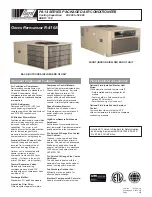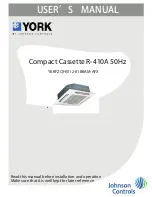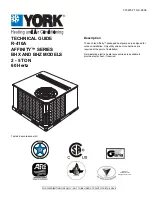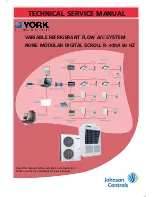
SS-SVX11K-EN
109
N
NO
OT
TIIC
CE
E
C
Co
om
mp
prre
esssso
orr D
Da
am
ma
ag
ge
e!!
E
Ex
xcce
essssiiv
ve
e lliiq
qu
uiid
d a
accccu
um
mu
ulla
attiio
on
n iin
n tth
he
e ssu
uccttiio
on
n lliin
ne
ess
cco
ou
ulld
d rre
essu
ulltt iin
n cco
om
mp
prre
esssso
orr d
da
am
ma
ag
ge
e..
D
Do
o n
no
ott a
allllo
ow
w lliiq
qu
uiid
d rre
effrriig
ge
erra
an
ntt tto
o e
en
ntte
err tth
he
e ssu
uccttiio
on
n
lliin
ne
e..
8. At the liquid line angle valve add as much R-410A
LIQUID as possible up to, but not exceeding, that
listed in
. Depending on conditions,
it could not be possible to add more than 60% of the
charge listed in the table. This will be adequate for
compressor startup. More charge will be added
after compressors are started. Use an accurate
scale to measure and record the preliminary
amount of R-410A added to each circuit.
9. Do not add refrigerant in the suction line at this
time to prevent excessive refrigerant in the low side
prior to compressor startup.
Compressor Start-Up
(All Systems)
Table 34.
Minimum starting ambient temperature
Unit
Size
Minimum Starting Ambient
(a)
(°F)
Standard Units
Low Ambient Units
With
HGBP
No
HGBP
With
HGBP
No HGBP
20-60
45
40
10
0
80-120
45
40
10
0
(a)
Minimum starting ambients in degrees F and is based on the unit
operating at minimum step of unloading and 5 mph wind across
condenser.
1. Review "Adding Preliminary Charge" section and
confirm all steps were completed.
N
NO
OT
TIIC
CE
E
C
Co
om
mp
prre
esssso
orr D
Da
am
ma
ag
ge
e!!
F
Fa
aiillu
urre
e tto
o ffo
ollllo
ow
w iin
nssttrru
uccttiio
on
nss cco
ou
ulld
d rre
essu
ulltt iin
n
cco
om
mp
prre
esssso
orr d
da
am
ma
ag
ge
e..
K
Ke
ee
ep
p ccrra
an
nkkcca
asse
e h
he
ea
atte
errss o
on
n w
wh
he
en
ne
ev
ve
err rre
effrriig
ge
erra
an
ntt iiss
iin
n tth
he
e ssy
ysstte
em
m..
IIff ccrra
an
nkkcca
asse
e h
he
ea
atte
errss h
ha
av
ve
e n
no
ott b
be
ee
en
n o
on
n w
wiitth
h
rre
effrriig
ge
erra
an
ntt iin
n tth
he
e ssy
ysstte
em
m,, ttu
urrn
n tth
he
e ccrra
an
nkkcca
asse
e
h
he
ea
atte
errss o
on
n ffo
orr a
a m
miin
niim
mu
um
m o
off 2
24
4 h
ho
ou
urrss b
be
effo
orre
e
sstta
arrttiin
ng
g cco
om
mp
prre
esssso
orrss..
N
No
otte
e:: Initial compressor start-up is best done above
70°F outdoor temperature with ample evaporator
load (at least 70°F return air and 350 CFM/Ton)
N
No
otte
e::
gives the minimum starting
temperatures for both "Standard" & "Low"
Ambient units
IIm
mp
po
orrtta
an
ntt:: Do not attempt to charge the system with
the low ambient dampers and/or hot gas
bypass operating (if applicable). Disable
low ambient dampers in the "Open"
position (refer to the "Low Ambient
Damper Adjustment" section) and verify
hot gas bypass is not operating before
proceeding.
2. On units with dual circuits, work on only one circuit
at a time. See tables in Compressor Sequencing
section for the compressor sequencing and
Operating Principals chapter Component Location
illustrations for their location..
3. Compare the amount of preliminary charge added
in the proceeding section to the table in that section
for condensing unit and piping only. Up to 20%
more charge than listed in that table may be
required to fully charge the circuit, depending on
the evaporator design. Have adequate R-410A
available to complete charging as described in the
following steps.
4. Attach a thermocouple type temperature sensor on
the liquid line close to the liquid line service valve.
To insure an accurate liquid temperature reading,
clean the line where the sensor is attached. After
securing the sensor to the line, insulate the sensor
and line to isolate it from the ambient air.
5. Attach a set of service gauges onto the suction and
discharge gauge ports.
6. Check the low side pressure. The low pressure
cutout (4S3, 4S4) opens below 58 psig and closes
above 78 psig. If the low side pressure is less than
78 psig, refrigerant may need to be added to the
suction line before starting the compressor(s).
Slowly meter into the suction line only as much R–
410A as needed to make the low pressure cutout
from the VAPOR charging connection. If possible,
plan to use this entire refrigerant bottle on the same
unit in order to minimize fractionalization. Use an
accurate scale to measure and record the amount of
R-410A added.
W
WA
AR
RN
NIIN
NG
G
H
Ha
azza
arrd
do
ou
uss V
Vo
olltta
ag
ge
e!!
F
Fa
aiillu
urre
e tto
o d
diisscco
on
nn
ne
ecctt p
po
ow
we
err b
be
effo
orre
e sse
errv
viicciin
ng
g cco
ou
ulld
d
rre
essu
ulltt iin
n d
de
ea
atth
h o
orr sse
erriio
ou
uss iin
njju
urry
y..
D
Diisscco
on
nn
ne
ecctt a
allll e
elle
eccttrriicc p
po
ow
we
err,, iin
nccllu
ud
diin
ng
g rre
em
mo
otte
e
d
diisscco
on
nn
ne
eccttss b
be
effo
orre
e sse
errv
viicciin
ng
g.. F
Fo
ollllo
ow
w p
prro
op
pe
err
llo
occkko
ou
utt//tta
ag
go
ou
utt p
prro
occe
ed
du
urre
ess tto
o e
en
nssu
urre
e tth
he
e p
po
ow
we
err
cca
an
n n
no
ott b
be
e iin
na
ad
dv
ve
errtte
en
nttlly
y e
en
ne
errg
giizze
ed
d.. V
Ve
erriiffy
y tth
ha
att n
no
o
p
po
ow
we
err iiss p
prre
esse
en
ntt w
wiitth
h a
a v
vo
ollttm
me
ette
err..
7. Switch the field supplied unit disconnect "OFF".
Open the unit control box and plug in the reset
relay (1K21 or 1K22) for the circuit being started
only.
8. This charging procedure is more accurate at higher
















































